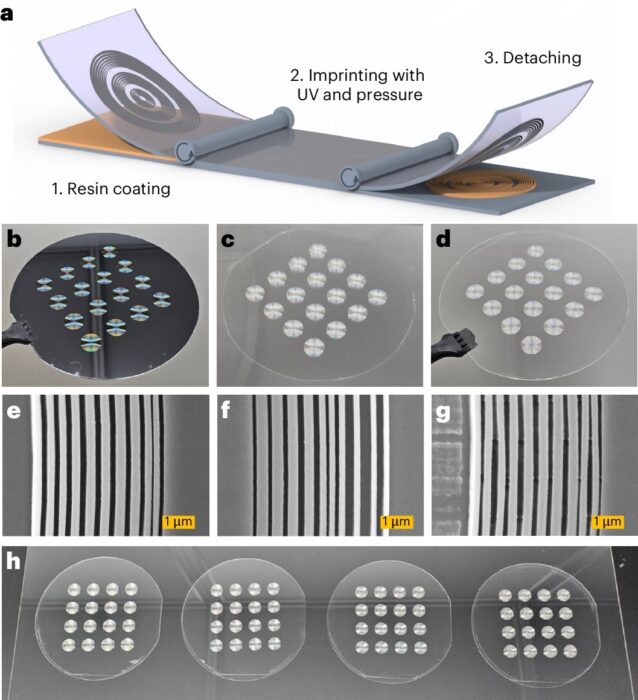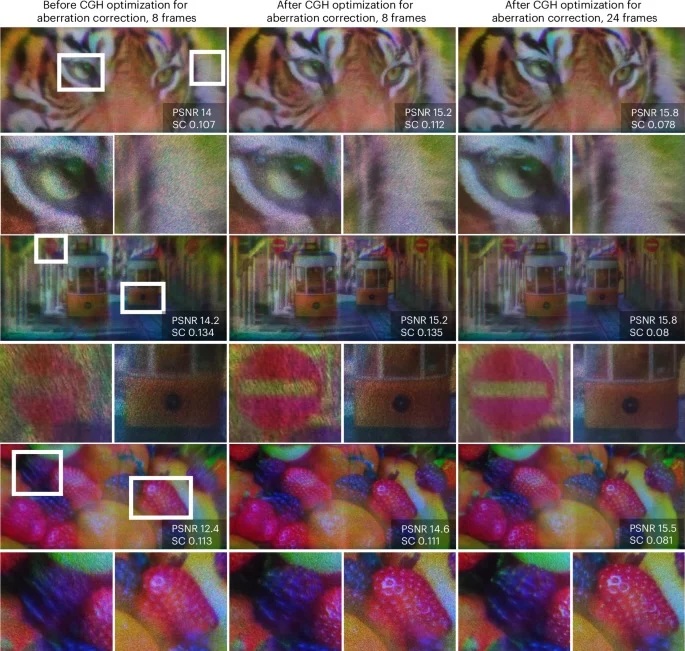
In General XR News
February 25, 2025 – Samsung Electronics has today announced that it has published a joint research paper with Pohang University of Science and Technology (POSTECH) in South Korea detailing the development of an achromatic metalens in the academic journal Nature Materials.
According to Samsung, the paper, titled “Roll-to-plate printable RGB-achromatic metalens for wide-field-of-view holographic near-eye displays,” reflects the findings of research conducted by Samsung and POSTECH’s joint research team, wherein they developed an achromatic metalens free from color distortions and combined it with holographic displays to address various optical imperfections and irregularities.
What is a metalens?
A metalens is a flat lens composed of nanoscale structures capable of controlling light diffraction, which can drastically reduce size and thickness compared to traditional convex optical lenses. While a convex lens typically has a thickness of several millimeters, sometimes exceeding a centimeter, metalenses are much thinner, usually less than 0.5 mm. For this reason, they have been recognized as a potential next-generation optical component for applications in displays and cameras, according to Samsung.

The company also noted that despite these advantages, metalenses have encountered technical challenges in product development due to severe chromatic aberration, also known as color fringing, which occurs when a lens fails to focus all colors to the same point, creating colored fringes along the edges of objects in photographs and leading to significant image distortion.
To address chromatic aberration, the research team redefined the conventional design approach for metalenses. By accounting for the interrelationships between all metastructures during the design phase and designing them simultaneously (as opposed to designing individual metastructures independently and subsequently assembling them onto a substrate), the team reported successful elimination of chromatic aberration after fabrication.
Additionally, Samsung stated that as well as eliminating chromatic aberration, the achromatic metalens developed by the research team also achieves a shorter focal length, helping to significantly reduce the lens’ size and weight.
How achromatic metalenses could enhance XR displays
Metalenses typically suffer from optical aberrations beyond chromatic aberration, with image distortion worsening as screen size increases. These issues are usually addressed by combining multiple lenses, but the research team resolved them by integrating a single achromatic metalens with a holographic display, achieving a wide field of view and clear, distortion-free images.
Samsung added that technical validation further showed that replacing conventional lenses and displays with achromatic metalenses and holographic displays can produce compact, lightweight designs that deliver virtual images that cause less eye strain.

From Research to Reality — What’s Next?
In its announcement on the research findings, Samsung stated: “Through this collaboration between industry and academia, Samsung has validated the entire process—from conceptualizing innovative ideas to implementation—confirming the potential for advancing various future optical systems and securing next-generation display technologies.”
Samsung stated that the new research findings could support the development of compact, high-quality holographic XR wearables and immersive media devices, as well as various optical systems—including displays, cameras, and sensors—to enhance performance and reduce size.
The study was led by Dr. Seokil Moon from Samsung Research and Professor Junsuk Rho from POSTECH, with researchers Minseok Choi, Joohoon Kim and Kilsoo Shin from POSTECH also listed as co-authors of the paper.
Image credit: Samsung / Nature Materials
About the author
Sam is the Founder and Managing Editor of Auganix. With a background in research and report writing, he has been covering XR industry news for the past seven years.
